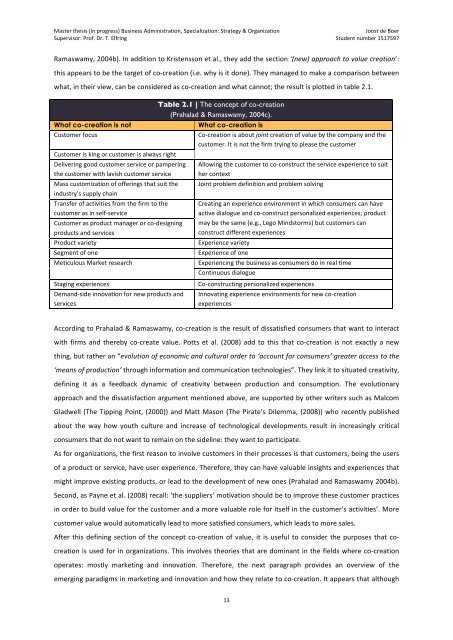Download PDF (English) - Future Ideas
Download PDF (English) - Future Ideas
Download PDF (English) - Future Ideas
Create successful ePaper yourself
Turn your PDF publications into a flip-book with our unique Google optimized e-Paper software.
Master thesis (in progress) Business Administration, Specialization: Strategy & Organization <br />
Supervisor: Prof. Dr. T. Elfring <br />
Joost de Boer <br />
Student number 1517597 <br />
Ramaswamy, 2004b). In addition to Kristensson et al., they add the section ‘(new) approach to value creation’: <br />
this appears to be the target of co-‐creation (i.e. why is it done). They managed to make a comparison between <br />
what, in their view, can be considered as co-‐creation and what cannot; the result is plotted in table 2.1. <br />
What co-creation is not<br />
Customer focus <br />
Customer is king or customer is always right <br />
Delivering good customer service or pampering <br />
the customer with lavish customer service <br />
Mass customization of offerings that suit the <br />
industry’s supply chain <br />
Transfer of activities from the firm to the <br />
customer as in self-‐service <br />
Customer as product manager or co-‐designing <br />
products and services <br />
Product variety <br />
Segment of one <br />
Meticulous Market research <br />
Staging experiences <br />
Demand-‐side innovation for new products and <br />
services <br />
Table 2.1 | The concept of co-creation<br />
(Prahalad & Ramaswamy, 2004c).<br />
What co-creation is<br />
Co-‐creation is about joint creation of value by the company and the <br />
customer. It is not the firm trying to please the customer <br />
Allowing the customer to co-‐construct the service experience to suit <br />
her context <br />
Joint problem definition and problem solving <br />
Creating an experience environment in which consumers can have <br />
active dialogue and co-‐construct personalized experiences; product <br />
may be the same (e.g., Lego Mindstorms) but customers can <br />
construct different experiences <br />
Experience variety <br />
Experience of one <br />
Experiencing the business as consumers do in real time <br />
Continuous dialogue <br />
Co-‐constructing personalized experiences <br />
Innovating experience environments for new co-‐creation <br />
experiences <br />
According to Prahalad & Ramaswamy, co-‐creation is the result of dissatisfied consumers that want to interact <br />
with firms and thereby co-‐create value. Potts et al. (2008) add to this that co-‐creation is not exactly a new <br />
thing, but rather an “evolution of economic and cultural order to ‘account for consumers’ greater access to the <br />
‘means of production’ through information and communication technologies”. They link it to situated creativity, <br />
defining it as a feedback dynamic of creativity between production and consumption. The evolutionary <br />
approach and the dissatisfaction argument mentioned above, are supported by other writers such as Malcom <br />
Gladwell (The Tipping Point, (2000)) and Matt Mason (The Pirate’s Dilemma, (2008)) who recently published <br />
about the way how youth culture and increase of technological developments result in increasingly critical <br />
consumers that do not want to remain on the sideline: they want to participate. <br />
As for organizations, the first reason to involve customers in their processes is that customers, being the users <br />
of a product or service, have user experience. Therefore, they can have valuable insights and experiences that <br />
might improve existing products, or lead to the development of new ones (Prahalad and Ramaswamy 2004b). <br />
Second, as Payne et al. (2008) recall: ‘the suppliers’ motivation should be to improve these customer practices <br />
in order to build value for the customer and a more valuable role for itself in the customer’s activities’. More <br />
customer value would automatically lead to more satisfied consumers, which leads to more sales. <br />
After this defining section of the concept co-‐creation of value, it is useful to consider the purposes that co-creation<br />
is used for in organizations. This involves theories that are dominant in the fields where co-‐creation <br />
operates: mostly marketing and innovation. Therefore, the next paragraph provides an overview of the <br />
emerging paradigms in marketing and innovation and how they relate to co-‐creation. It appears that although <br />
13





